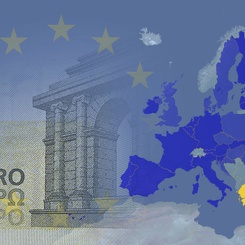Many European political leaders are calling for additional Keynesian-style fiscal stimulus packages as a possible means to stimulate growth and employment. Despite the German reserves, on June 28 and 29, 2012, the European Council approved the Compact for Growth and Jobs expected to boost the financing of the EU economy by 120 billion euro. Is this the most adapted response to the current state of affairs in the eurozone? I would argue that this approach threatens to worsen the economic difficulties of Europe.
For many years, the citizens of the most advanced economies have lived under the illusion that public debt presents no risk of default. While this belief might have made some sense in the sixties, when public debts amounted to less than half of the GDP, today, the threat of default is tangible, as many countries head towards the scary threshold of 100% debt-to-GDP ratio. For sure, this public debt surge can in part be attributed to the Great Recession of 2007-2009. That said, public liabilities were on the rise well before the crisis, regardless of the political orientation of successive governments.
Calls for a fiscal stimulus are based on a now outdated version of the Keynesian model of the economy, which does not take into account financial risks. In particular, this elementary model ignores the impact of higher deficits and debts on the illiquidity risk of default, and the investment crowding-out effect that higher risk-adjusted interest rates can bring about. The impact on growth of a given fiscal stimulus can be weak or strong depending on the amount of public debt and its perceived sustainability. If the public debt is too large and investors doubt about the ability of governments to pay-back, the rise in interest rates after a fiscal stimulus will be amplified and private investment will be crowded-out; in turn, this will reduce the effectiveness of the initial stimulus plan.
As you will notice in Table 1, in 2011 there has been a strongly negative relationship between the annual growth rate in 30 European countries and their debt-to-GDP ratios. In a recent empirical paper on a panel of 26 European countries (Vranceanu and Besancenot, 2012), we show that in the last 15 years the effectiveness of fiscal policy was negatively affected by a high public debt-to-GDP ratio, and high debt levels can be associated to low growth rates. A negative relationship between growth and public debt in the long run has already been unveiled by two IMF economists, Manmohan Kumar and Jaejoon Woo. In another study, Carmen Reinhart and Kenneth Rogoff have shown that growth is significantly lower in countries that have a debt-to-GDP ratio above 90%, as compared to countries with a debt-to-GDP below this threshold.
When we look more closely, we also find that those countries using the common currency are facing bigger challenges when it comes to public debt sustainability and management, even though the average debt-to-GDP ratio is not as high as those of the United Kingdom or United States, for example.
Why is this the case? Primarily because the group of countries that created the euro initially chose to prevent the European Central Bank (ECB) from bailing out governments, even if these governments were solvent but temporary illiquid. However, as Besancenot, Huynh and Vranceanu have shown in a “premonitory” paper in 2005, when the risk of illiquidity is coupled with even a remote risk of insolvency, it can drag public debt on an unsustainable path. Therefore, without a lender of last resort, no euro area government with a debt-to-GDP ratio above 40% is really isolated from the risk of default.
Of course, this illiquidity risk could be contained if euro area countries were to grant the ECB the ability to monetize debts. Like the UK and the US, euro area governments would then have the flexibility to push deficits and public debt even further. That said, this would open the door to what might become the systematic abuse of Europeans citizens’ confidence and postpone a deeper crisis should public debts keep on rising. Can we change the ECB statute and rules of action before testing the ability of all euro governments to control their spending?
Many EU observers argue that the only way out of this messy situation is to push integration further, even as far as a European federation with a central government. In total disagreement with them, I argue that what we need now is ordered disintegration, with an EU focused on the goal of free trade, and a renewed respect for diversity and freedom.
References:
Besancenot, Damien, Kim Huynh, Radu Vranceanu, 2004, Default on sustainable public debt: Illiquidity suspect convicted, Economics Letters, 82, 2, pp. 205-211.
Kumar, Manmohan and Jaejoon Woo, 2010, Public debt and growth, IMF Working Paper, WP/10/174.
Reinhart, Carmen and Kenneth Rogoff, 2010, Growth in a time of debt, American Economic Review, 100, 2, pp. 573-578.
Vranceanu, Radu and Damien Besancenot, 2012, Fiscal stimulus in a time of massive public debt, Essec Working Paper, July 2012.









